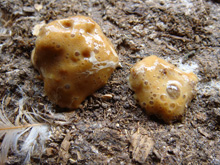
The advice hub Diarrhoea in backyard poultry
Alongside respiratory disease - diarrhoea is one of the most common conditions to affect your chickens. Normal chicken droppings should be firm and brown with a white part on the top which is made from urates (the chicken’s urine) as chickens urinate and defecate in one motion. Any yellow foamy droppings or bloody droppings are abnormal.

There are a number of possible causes for diarrhoea in poultry:
- Coccidiosis
- Worms
- Viruses (such as rotavirus and adenovirus)
- Bacterial diarrhoea, caused by an infection
- Kidney damage
- A feed too high in protein
- The chicken is not eating properly
Coccidiosis tends to cause depression and bloody diarrhoea in poultry between 4 and 10 weeks of age, severe cases can lead to death. If you suspect your birds have coccidiosis seek veterinary help immediately.
Worms rarely actually cause diarrhoea in chickens but if present in large numbers they irritate the gut which causes a secondary bacterial diarrhoea. Worm your chickens as a guide twice a year to prevent high levels of worms developing or use one of the Chicken Vet Faeces Sampling Kit.
Viruses can damage the gut causing diarrhoea such as rotavirus and adenovirus (in turkeys). Medications will not treat a virus but there are products that will help to support the bird whilst it fights the virus. However, when a virus damages a chicken's intestine it allows harmful bacteria to grow out of control in the intestine leading to a secondary bacterial diarrhoea.
Bacterial diarrhoea is simply a disruption in the normal balance of good and bad bacteria in the intestine. Commonly this results in an overgrowth of harmful Clostridia bacteria. It is thought that there is usually an underlying reason for this disruption such as:
- Gut damage caused by worms, coccidiosis or viruses
- A sudden change in diet (different foods encourage different bacterial species to grow in the gut and a sudden change in feed can cause an overwhelming change in gut bacteria species)
- Dirty water (this will mean your chicken will be drinking lots of harmful bacteria)
- Mouldy feed (mouldy feed contains fungal toxins which can cause gut damage)
Once the harmful bacteria take hold it can damage the wall of the gut leading to further diarrhoea. In severe cases, the wall of the gut can become badly damaged enabling infective bacteria to pass from the gut into the blood stream resulting in blood poisoning which can be fatal.
Kidney damage. If a bird is suffering from kidney damage many owners will report diarrhoea. Often this is confused with the fact that the kidney damage causes the kidneys to produce excessive quantities of urine, this mixes with the droppings before defecation, causing them to be more watery than normal. So you are actually seeing more urine.
Incorrect diets for species or which contain excessive levels of protein causes wetter droppings as the extra protein is converted into urates. This causes your chicken to drink more water therefore you will see an increase in urine leading to wet, damp bedding.
Irrespective of the cause of diarrhoea it has a number of harmful effects:
- Less absorption of nutrients therefore causing your chicken to become lethargic and lose weight
- Gut cannot absorb as much water as normal causing your chicken to become dehydrated which can lead to death
- In severe cases the damaged gut wall will allow bacteria to leave the gut and enter the blood stream causing blood poisoning and death
- Diarrhoea leads to the feathers around the rear end to become dirty and matted plus the bedding can become both wet and contaminated. The contaminated bedding can become a source of infection for the rest of the flock. Use Chicken Vet Dri Bed in this situation.


